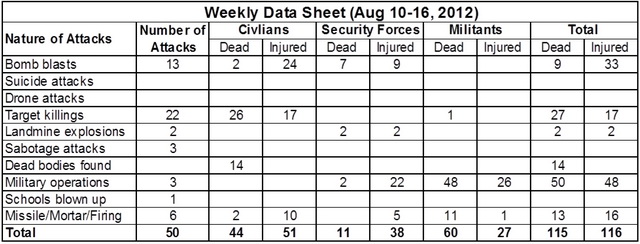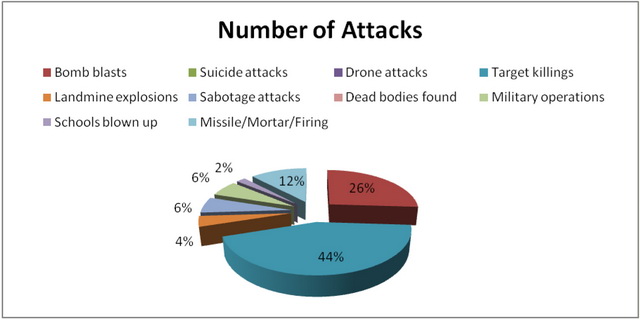The overall level of violence escalated substantially across Pakistan during the week. Meanwhile, the spree of target killings in Karachi (Sindh), military-militants– clashes in Federally Administered Tribal Areas (FATA) and series of bomb blasts rocked Pakistan during the week. The data collected (throughten newspapers that CRSS uses as the source) suggests that as many as 115 persons fell prey to 50 incidents of violence across the country during the reported week (for detailssee data sheet).These violent incidents also left 116 people injured across the country.
Contrary to the preceding two weeks, wherein civilians endured the maximum loss, militants bore the major brunt of the ongoing violence across the country. Sixty militants got killed and another fourteen injured under different circumstances. The second highest number of casualties were ofcivilians, wherein, as many as,44 civilians were killed and 51 others got wounded. Furthermore, like the previous week noCIA operated drone strikewas reported in any part of the country. Moreover, sabotage attacks by the miscreants once again picked up during the reporting week as two power pylons and a portion of railway track was blown up by the miscreants in KP and Balochistan provinces respectively. Militants also blew up a government primary school in Mardan district (KP).
Unlike the preceding week, three sectarian attacks were witnessed during this week, wherein three activists of Sunni Tehrik (ST) and a Shia man were killed in different areas of Karachi (Sindh). Moreover, casualties due to the relentless wave of target killings were down by five percent. Overall, 44 percent of the total violent attacks wereoftarget killingin nature.The trend also suggests that the target killing remains responsible for the most number of deaths in the ongoing violent conflicts around the country (seethe pie chart below).
Furthermore, data shows that of the total 22 incidents of target killings, a staggering 63 percent took place in Karachi alone, killing 18 people and injuring another thirteen. Militant casualties in the ongoing military operations in KP and FATA region surged sharply by 86 percent as 48 militants got killed this week against last week seven. Overall militant casualties accounted for 43 percent of the total death toll. Meanwhile, 11 security personnel lost their lives and 38 others got injured as a result of clashes with the militants during the week.
Moreover, the phenomenon of recovery of dead bodies yet again changed its terrain and this time shifted to KP, as of the total 14, 64 percent, i.e. nine dead bodies, were recovered from KP province alone. In sum, the number of violent incidents increased considerably from last week 34 to 50 this week, the resultant fatalities also increased sharply (nearly doubled) from 64 to 115 during the current week. While the number of wounded swelled from 62 to 116.
A concise look into the data and trends of violence across Pakistan suggests that violence is evenly spread in Balochistan, Karachi, FATA and KP. The salient features of the week were the wave of bomb blasts, sectarian attacks, sabotage attacks and recovery of dead bodies. It also underlines that security situation in the country continues to paint grim picture at a time when the civilian government has locked horns with the judiciary. Furthermore, it seems that the government has left the security issues to the security establishment, whereas all the security issues need political intervention. Thus the violence has become ‘new normal’ due to the political apathy of the civilian government, with no signs of immediate end.
Sources
- The News
- Dawn
- The Express Tribune
- Pakistan Today
- Daily Times
- The Frontier Post
- Jang (Urdu)
- Daily Mashriq (Urdu)
- Aaj (Urdu)
- The Nation


